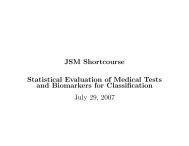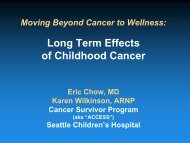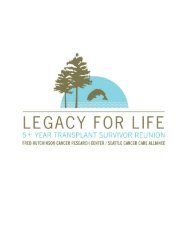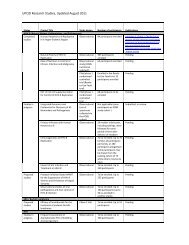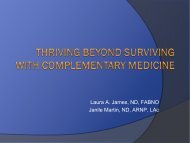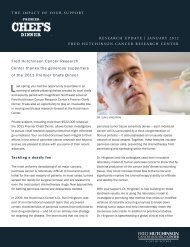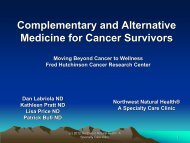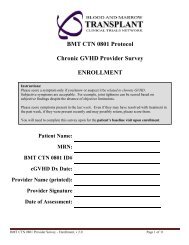Summer Undergraduate Research Program - Fred Hutchinson ...
Summer Undergraduate Research Program - Fred Hutchinson ...
Summer Undergraduate Research Program - Fred Hutchinson ...
You also want an ePaper? Increase the reach of your titles
YUMPU automatically turns print PDFs into web optimized ePapers that Google loves.
Profiling gene expression differences and immune cell populations in HIV exposed seronegative<br />
individuals [HESN] and seroconverters<br />
Augustine Ajuogu1, 2, 3 , Chloe Slichter 2,3 , Laura Pattacini, 3 and Jennifer Lund, 2,3<br />
1Northwest University, Kirkland, WA; 2Vaccine and Infectious Disease Division, <strong>Fred</strong> <strong>Hutchinson</strong> Cancer <strong>Research</strong><br />
Center, Seattle, WA; 3Department of Global Health, University of Washington, Seattle, WA<br />
2012 Best Poster Presentation Award<br />
Methodology Results<br />
Background<br />
Question 1: Do gene expression levels differ between seroconverters and HESN samples?<br />
Answer: Previous unpublished data supports our hypothesis, however we are still in the<br />
process of analyzing the data and have yet to determine the results<br />
Study cohorts<br />
The peripheral blood mononuclear cells (PBMC) samples analyzed were either from exposed seronegative<br />
subjects or from seroconverters. Seroconverters samples were obtained from the last visit before<br />
seroconversion. All samples were obtained from two different cohorts: Partners in Prevention HSV/HIV<br />
Transmission Study, Couples Observational Study, and Partner’s Pre-Exposure Prophylaxis study (PREP).<br />
With more than 1.8 million deaths per year, HIV remains the most<br />
devastating disease around the globe. Disease and death in HIV patients<br />
can be attributed to various factors including the inability of the host<br />
immune system to independently suppress or clear the infection.<br />
Question 2: Are there statistical differences in immune cell populations between<br />
seroconverters and HESN samples?<br />
Answer: No, there are no distinct differences between frequency of immune cells between<br />
the two cohorts.<br />
2a. Samples shipped for RNA gene<br />
expression analysis<br />
Some studies show that few individuals do not become infected after<br />
continued and prolonged exposure without the aid of antiretroviral<br />
therapy [HESN] .<br />
CD56-<br />
NK Cells<br />
CD8+ CD8+ T-Cell<br />
CD4<br />
CD4+ T-Cell<br />
Serodiscordant couples in which one partner is HIV positive and the<br />
other is HIV negative are of interest in understanding such phenomenon.<br />
4. Immune cell frequency analysis<br />
150<br />
60<br />
100<br />
100<br />
40<br />
50<br />
Phenoype Population<br />
80<br />
60<br />
40<br />
20<br />
20<br />
Phenotype Frequency<br />
1. PBMC Samples processed for<br />
gene expression studies and<br />
cell phenotyping<br />
0<br />
HESN<br />
Preinfection<br />
0<br />
0<br />
HESN<br />
Preinfection<br />
HESN<br />
Pre infection<br />
P value: 0.7585<br />
Summary: ns.<br />
P value: 0.7390<br />
Summary: ns.<br />
P value: 0.5381<br />
Summary: ns.<br />
3. Samples stained with specific markers<br />
and fluorochrome<br />
2b. Samples plated<br />
Figure 2: Simplified methodology diagram<br />
CD19+ CD19+ B-Cells<br />
Monocytes<br />
50<br />
40<br />
100<br />
112<br />
80<br />
30<br />
20<br />
60<br />
Sample processing for immune cell population phenotyping and gene expression studies<br />
Samples were processed via standard procedures and divided into two aliquots to determine the frequency<br />
of specific lymphocyte populations and to investigate gene expression of these specific populations.<br />
40<br />
10<br />
0<br />
Phenotype Frequency<br />
20<br />
0<br />
Phenotype population<br />
HESN<br />
Pre-infection<br />
HESN<br />
P value: 0.2818<br />
Summary: ns.<br />
Preinfection<br />
P value: 0.4436<br />
Summary: ns.<br />
Lymphocyte populations were identified using flow cytometry. Phenotyping for various subsets including T<br />
cells, B cells, Monocytes, plasmocytoid dendritic cells, myeloid dendritic cells, and natural killer cells by the<br />
expression of various cellular markers was performed.<br />
Figure 4: PBMC Frequencies<br />
Conclusion & . Discussion<br />
In order to provide confidence in our results, we performed a series of experiments to establish working<br />
antibody concentrations (titers). Furthermore, we performed a full fluorescence minus one (FMO) panel<br />
utilizing titers already established to draw the specific gates for each cell population. Cell populations were<br />
analyzed using FlowJo and Prism software.<br />
Our experiment revealed no statistically significant difference in frequency of immune cell<br />
populations between the HESN and seroconverters at the time point prior to seroconversion.<br />
Samples from subjects sent for gene expression studies are still being analyzed and thus may<br />
provide unique signature of protection or susceptibility to HIV infection.<br />
250K<br />
200K<br />
150K<br />
98.6<br />
100K<br />
88.9<br />
10<br />
50K<br />
73.9<br />
0<br />
0<br />
0 50K 100K 150K 200K 250K<br />
0 50K 100K 150K 200K 250K<br />
FSC-A<br />
FSC-A<br />
PBMCs<br />
S<br />
211058.fcs<br />
211058.fcs<br />
Event Count: 57940<br />
Event Count: 65154<br />
2<br />
10 3<br />
10 4<br />
10 5<br />
99.4<br />
10 5<br />
10 5<br />
Singlets<br />
Lymphocyte-PBMCs<br />
Alive<br />
CD3+ CD3+<br />
CD3-<br />
CD4+/CD8+ T cells<br />
CD19+ B lymhocytes<br />
250K<br />
200K<br />
Figure 1: Seronegative vs. HESN individual<br />
In some cases, individuals can resist infection after repeated and<br />
prolonged exposure but eventually acquire the virus (seroconverters).<br />
The differences between HESN and seroconverters are not fully<br />
understood, but immune responses to the virus are well documented in<br />
both groups.<br />
Future Directions .<br />
: L/D<br />
150K<br />
SSC-A<br />
FSC-H<br />
100K<br />
50K<br />
0<br />
Investigate immune cell populations at different time points before and after seroconversion<br />
o Immune cell populations may change during exposure to HIV<br />
Evaluate cell populations for activation markers<br />
o Though immune cell frequency may not change, activation markers in HESN<br />
0 50K 100K 150K 200K 250K<br />
FSC-A<br />
Ungated<br />
211058.fcs<br />
Event Count: 66101<br />
Specific Aims<br />
CD3-<br />
NK cells<br />
10 5<br />
Quantify and compare gene expression levels in HESN and<br />
seroconverters via microarray technology.<br />
10 4<br />
Acknowledgements<br />
Acknowledgments<br />
may differ from seroconverters.<br />
23.1<br />
10 3<br />
: CD16<br />
: CD19<br />
: CD4<br />
: CD3<br />
0<br />
3 104 105<br />
0 10<br />
: CD56<br />
CD3-<br />
211058.fcs<br />
Event Count: 8897<br />
10<br />
0<br />
2<br />
0 10 103 104 105<br />
: CD8<br />
CD3+<br />
211058.fcs<br />
Event Count: 39014<br />
3<br />
10 4<br />
69.1<br />
10<br />
24.5<br />
0<br />
0 50K 100K 150K 200K 250K<br />
FSC-A<br />
Alive<br />
211058.fcs<br />
Event Count: 47922<br />
3<br />
10 4<br />
10 5<br />
81.4<br />
10<br />
18.6<br />
0<br />
0 50K 100K 150K 200K 250K<br />
FSC-A<br />
CD3-<br />
211058.fcs<br />
Event Count: 8897<br />
3<br />
10 4<br />
48.5<br />
51.5<br />
10<br />
0<br />
0 50K 100K 150K 200K 250K<br />
FSC-A<br />
Alive<br />
211058.fcs<br />
Event Count: 57620<br />
2<br />
10 3<br />
10 4<br />
10 5<br />
1.21<br />
10<br />
0<br />
0 50K 100K 150K 200K 250K<br />
FSC-A<br />
Alive<br />
211058.fcs<br />
Event Count: 57620<br />
2<br />
10 3<br />
10 4<br />
10 5<br />
14.7<br />
10<br />
0<br />
2<br />
0 10 103 104 105<br />
: CD11c<br />
HLA-DR+<br />
211058.fcs<br />
Event Count: 8465<br />
2<br />
10 3<br />
10 4<br />
10 5<br />
CD14+ HLA-DR + HLA-DR +<br />
CD11c+ mDCs<br />
48.1<br />
Figure 3: Full Panel and gating scheme for immune cell population.<br />
Profile immune cell frequencies in both HESN and seroconverters via<br />
flow cytometry to assist in de-convolution analysis in order to evaluate<br />
specific expression levels within specific immune cell types of both<br />
populations.<br />
I am indebted to Dr. Laura Pattacini both for her faithful mentorship and her grace. I thank Dr.<br />
Jairam Lingappa for the project, and Dr. Jennifer Lund for the opportunity to work in her lab. A<br />
special thank you to Chloe Slichter and the entire lab for their assistance. I thank Rafick Sekaly<br />
and his entire lab for their help with the RNA gene expression studies of samples. My work is<br />
made possible by the <strong>Fred</strong> <strong>Hutchinson</strong> Cancer <strong>Research</strong> Center <strong>Summer</strong> <strong>Undergraduate</strong> <strong>Research</strong><br />
<strong>Program</strong>. The <strong>Summer</strong> <strong>Undergraduate</strong> <strong>Research</strong> <strong>Program</strong> is supported in part by the Cancer<br />
Center Support Grant (CCSG) CURE Supplement: 5 P30 CA015704-37S1. This research is also<br />
supported in part by NIAID/NIH 3 R01 AI047086-10S1.<br />
HLA-DR +<br />
CD123+ pDCs<br />
10 5<br />
0.732<br />
10 4<br />
Rationale .<br />
10 3<br />
: HLA-DR<br />
: HLA-DR<br />
: HLA-DR<br />
: CD14<br />
10<br />
0<br />
2<br />
2<br />
103 104 105<br />
: CD123<br />
0 10<br />
HLA-DR+<br />
211058.fcs<br />
Event Count: 8465<br />
Our study may identify genes and immune cell populations important to HIV<br />
acquisition. Results will in addition enable a better understanding of host<br />
resistance to HIV infection which is critical to vaccine and drug<br />
development.




